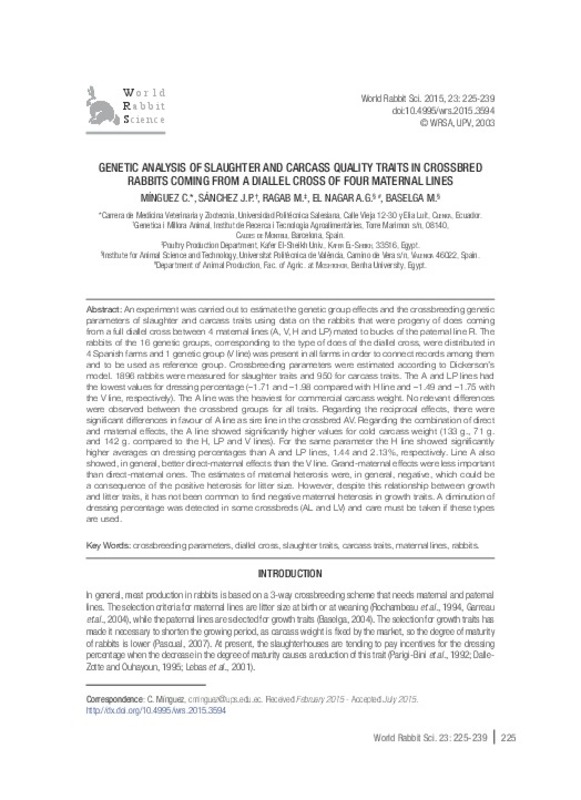JavaScript is disabled for your browser. Some features of this site may not work without it.
Buscar en RiuNet
Listar
Mi cuenta
Estadísticas
Ayuda RiuNet
Admin. UPV
Genetic analysis of slaughter and carcass quality traits in crossbred rabbits coming from a diallel cross of four maternal lines
Mostrar el registro sencillo del ítem
Ficheros en el ítem
| dc.contributor.author | Mínguez, C.
|
es_ES |
| dc.contributor.author | Sáchez, J.P.
|
es_ES |
| dc.contributor.author | Ragab, M.
|
es_ES |
| dc.contributor.author | El Nagar, Ayman Gamal Fawzy
|
es_ES |
| dc.contributor.author | Baselga Izquierdo, Manuel
|
es_ES |
| dc.date.accessioned | 2016-06-24T11:24:49Z | |
| dc.date.available | 2016-06-24T11:24:49Z | |
| dc.date.issued | 2015-12-23 | |
| dc.identifier.issn | 1257-5011 | |
| dc.identifier.uri | http://hdl.handle.net/10251/66432 | |
| dc.description.abstract | [EN] An experiment was carried out to estimate the genetic group effects and the crossbreeding genetic parameters of slaughter and carcass traits using data on the rabbits that were progeny of does coming from a full diallel cross between 4 maternal lines (A, V, H and LP) mated to bucks of the paternal line R. The rabbits of the 16 genetic groups, corresponding to the type of does of the diallel cross, were distributed in 4 Spanish farms and 1 genetic group (V line) was present in all farms in order to connect records among them and to be used as reference group. Crossbreeding parameters were estimated according to Dickerson’s model. 1896 rabbits were measured for slaughter traits and 950 for carcass traits. The A and LP lines had the lowest values for dressing percentage (–1.71 and –1.98 compared with H line and –1.49 and –1.75 with the V line, respectively). The A line was the heaviest for commercial carcass weight. No relevant differences were observed between the crossbred groups for all traits. Regarding the reciprocal effects, there were significant differences in favour of A line as sire line in the crossbred AV. Regarding the combination of direct and maternal effects, the A line showed significantly higher values for cold carcass weight (133 g., 71 g. and 142 g. compared to the H, LP and V lines). For the same parameter the H line showed significantly higher averages on dressing percentages than A and LP lines, 1.44 and 2.13%, respectively. Line A also showed, in general, better direct- maternal effects than the V line. Grand-maternal effects were less important than direct-maternal ones. The estimates of maternal heterosis were, in general, negative, which could be a consequence of the positive heterosis for litter size. However, despite this relationship between growth and litter traits, it has not been common to find negative maternal heterosis in growth traits. A diminution of dressing percentage was detected in some crossbreds (AL and LV) and care must be taken if these types are used. | es_ES |
| dc.description.sponsorship | This work was supported by Spanish project AGL2011-30170- C02-01 from the Spanish National Research Plan. C. Minguez acknowledges a Formacion de Personal Investigador (FPI) grant from the Ministerio de Economia y Competitividad (MEC), Spain. | en_EN |
| dc.language | Inglés | es_ES |
| dc.publisher | Editorial Universitat Politècnica de València | |
| dc.relation.ispartof | World Rabbit Science | |
| dc.rights | Reserva de todos los derechos | es_ES |
| dc.subject | Crossbreeding parameters | es_ES |
| dc.subject | Diallel cross | es_ES |
| dc.subject | Slaughter traits | es_ES |
| dc.subject | Carcass traits | es_ES |
| dc.subject | Maternal lines | es_ES |
| dc.subject | Rabbits | es_ES |
| dc.title | Genetic analysis of slaughter and carcass quality traits in crossbred rabbits coming from a diallel cross of four maternal lines | es_ES |
| dc.type | Artículo | es_ES |
| dc.date.updated | 2016-06-24T10:53:27Z | |
| dc.identifier.doi | 10.4995/wrs.2015.3594 | |
| dc.relation.projectID | info:eu-repo/grantAgreement/MICINN//AGL2011-30170-C02-01/ES/DIVERSIDAD GENETICA EN EL CONEJO DE CARNE. INTERACCIONES CON REPRODUCCION, CRECIMIENTO Y SALUD DIGESTIVA/ | es_ES |
| dc.rights.accessRights | Abierto | es_ES |
| dc.contributor.affiliation | Universitat Politècnica de València. Instituto de Ciencia y Tecnología Animal - Institut de Ciència i Tecnologia Animal | es_ES |
| dc.description.bibliographicCitation | Mínguez, C.; Sáchez, J.; Ragab, M.; El Nagar, AGF.; Baselga Izquierdo, M. (2015). Genetic analysis of slaughter and carcass quality traits in crossbred rabbits coming from a diallel cross of four maternal lines. World Rabbit Science. 23(4):225-239. https://doi.org/10.4995/wrs.2015.3594 | es_ES |
| dc.description.accrualMethod | SWORD | es_ES |
| dc.relation.publisherversion | https://doi.org/10.4995/wrs.2015.3594 | es_ES |
| dc.description.upvformatpinicio | 225 | es_ES |
| dc.description.upvformatpfin | 239 | es_ES |
| dc.type.version | info:eu-repo/semantics/publishedVersion | es_ES |
| dc.description.volume | 23 | |
| dc.description.issue | 4 | |
| dc.identifier.eissn | 1989-8886 | |
| dc.contributor.funder | Ministerio de Ciencia e Innovación |








